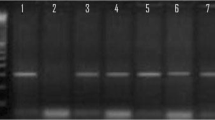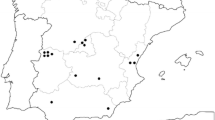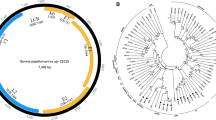Abstract
To determine if double-stranded RNA (dsRNA) viruses exist and are potential virulence factors in Trichomonas gallinae, virus purification via ultracentrifugation was attempted for 12 T. gallinae isolates recovered from wild birds. Following purification, virus-like particles were not observed by transmission electron microscopy, nor were dsRNA segments visualized in agarose gels after electrophoresis of extracted RNA from any of the 12 T. gallinae isolates. However, virus particles and dsRNA segments were detected from a previously determined virus-infected T. vaginalis isolate as a control using identical purification procedures. Subsequent reverse transcription-polymerase chain reaction analysis of the dsRNA of the virus in this isolate revealed a novel sequence of the RNA-dependent RNA polymerase gene of T. vaginalis viruses.

Similar content being viewed by others
References
Alderete JF (1999) Iron modulates phenotypic variation and phosphorylation of p270 in double-stranded RNA virus-infected Trichomonas vaginalis. Infect Immun 67:4298–4302
Alderete JF, Kasmala L, Metcalf E, Garza GE (1986) Phenotypic variation and diversity among Trichomonas vaginalis isolates and correlation of phenotype with trichomonal virulence determinants. Infect Immun 53:285–293
Benchimol M, Monteiro SP, Chang TH, Alderete JF (2002a) Virus in trichomonads-an ultrastructural study. Parasitol Int 51:293–298
Benchimol M, Chang TH, Alderete JF (2002b) Trichomonas vaginalis: observation of coexistence of multiple viruses in the same isolate. FEMS Microbiol Lett 10648:1–5
Diamond LS (1957) The establishment of various trichomonads of animals and man in axenic cultures. J Parasitol 46:545
Forrester DJ, Spalding MG (2003) Parasites and diseases of wild birds in Florida. University Press of Florida, Gainesville
Furfine ES, Wang CC (1990) Transfection of the Giardia lamblia double-stranded RNA virus into Giardia lamblia by electroporation of a single-stranded RNA copy of the viral genome. Mol Cell Biol 10:3659–3663
Gerhold RW, Tate CM, Gibbs SE, Mead DG, Allison AB, Fischer JR (2007) Necropsy findings and arbovirus surveillance in mourning doves (Zenaida macroura) from the southeastern United States. J Wildl Dis 43:129–135
Honigberg BM (1979) Biological and physiological factors affecting pathogenicity of trichomonads. In: Levandowsky M, Hunter SH (eds) Biochemistry and physiology of protozoa. Academic, New York, pp 409–427
Honigberg BM, Livingston MC, Stabler RM (1971) Pathogenicity transformation of Trichomonas gallinae I. Effects on homogenates and of mixtures of DNA and RNA from a virulent strain of pathogenicity of an avirulent strain. J Parasitol 57:929–938
Khoshnan A, Alderete JF (1993) Multiple double-stranded RNA segments are associated with virus particles infecting Trichomonas vaginalis. J Virol 67:6950–6955
Kniel KE, Higgins JA, Trout JM, Fayer R, Jenkins MC (2004) Characterization and potential use of a Cryptosporidium parvum virus (CPV) antigen for detecting C. parvum oocyts. J Microbiol Methods 58:189–195
Poulos BT, Tang KF, Pantoja CR, Bonami JR, Lightner DV (2006) Purification and characterization of infectious myonecrosis virus of penaeid shrimp. J Gen Virol 87:987–996
Provenzano D, Khoshnan A, Alderete JF (1997) Involvement of dsRNA virus in the protein composition and growth kinetics of host Trichomonas vaginalis. Arch Virol 142:939–952
Stabler RM (1954) Trichomonas gallinae: a review. Exp Parasitol 3:368–402
Stabler RM, Kihara JT (1954) Infection and death of the pigeon resulting from the oral implantation of single individuals of Trichomonas gallinae. J Parasitol 40:706
Vancini RG, Benchimol M (2005) Appearance of virus-like particles in Tritrichomonas foetus after drug treatment. Tissue Cell 37:317–323
Villanua D, Hofle U, Perez-Rodriguez L, Gortazar C (2006) Trichomonas gallinae in wintering common wood pigeons (Columba palumbus) in Spain. Ibis 148:641–648
Wang AL, Wang AC (1985) A linear double-stranded RNA in Trichomonas vaginalis. J Biol Chem 260:3697–3702
Wang AL, Wang AC, Alderete JF (1987) Trichomonas vaginalis phenotypic variation occurs only among trichomonads infected with the double-stranded RNA virus. J Exp Med 166:142–150
Wang AL, Yang HM, Shen KA, Wang CC (1993) Giardiavirus double-stranded RNA genome encodes a capsid polypeptide and a gag-pol-like fusion protein by a translation frameshift. Proc Natl Acad Sci USA 90:8595–8599
Widmer G, Comea AM, Furlong DB, Wirth D, Patterson JL (1989) Characterization of a RNA virus from the parasite Leishmania. Proc Natl Acad Sci USA 86:5979–5982
Acknowledgements
This investigation was supported primarily by Cooperative Agreement No. 2001-96130032-CA, Veterinary Services, APHIS, USDA; Cooperative Agreement 01ERAG0013, United States Geological Survey, Biological Resources Division, USDI; and sponsorship of SCWDS by the fish and wildlife agencies of Alabama, Arkansas, Florida, Georgia, Kentucky, Kansas, Louisiana, Maryland, Mississippi, Missouri, North Carolina, Ohio, Puerto Rico, South Carolina, Tennessee, Virginia, and West Virginia. Support from the states to SCWDS was provided in part by the Federal Aid to Wildlife Restoration Act (50 Stat. 917). Additional support was given by Quail Unlimited’s Dove Sportsman Society. We thank Danny Watson of the Kentucky Department of Fish Wildlife Resources, Autumn Smith of the Caesar Kleberg Research Institute-Texas A&M University, Jeff Cann from the California Department of Fish and Game, and Bill Mannan from the School of Renewable Natural Resources, University of Arizona for collection of isolates. Additionally, we thank Mary Ard, University of Georgia, for assistance with the electronic magnification.
Author information
Authors and Affiliations
Corresponding author
Rights and permissions
About this article
Cite this article
Gerhold, R.W., Allison, A.B., Sellers, H. et al. Examination for double-stranded RNA viruses in Trichomonas gallinae and identification of a novel sequence of a Trichomonas vaginalis virus. Parasitol Res 105, 775–779 (2009). https://doi.org/10.1007/s00436-009-1454-5
Received:
Accepted:
Published:
Issue Date:
DOI: https://doi.org/10.1007/s00436-009-1454-5




